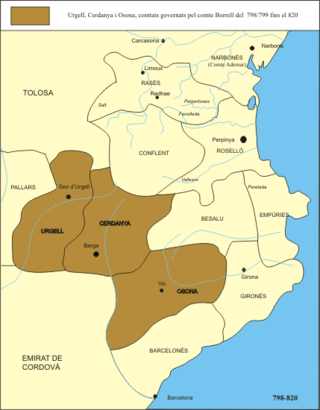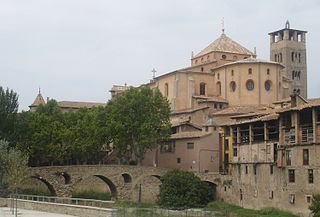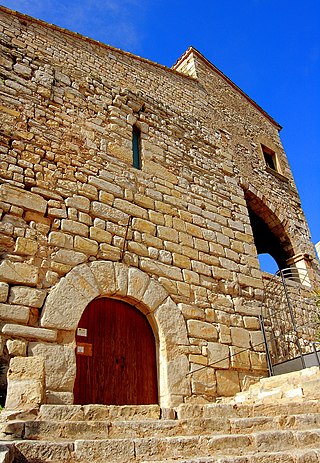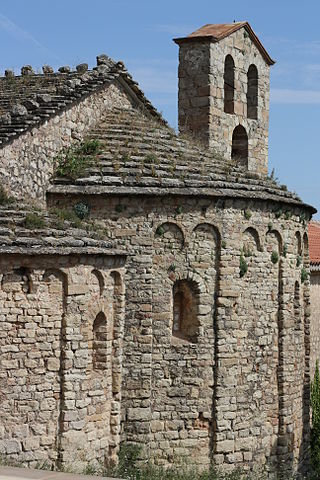Related Research Articles

Vic is the capital of the comarca of Osona, in the province of Barcelona, Catalonia, Spain. Vic is located 69 km (43 mi) from Barcelona and 60 km (37 mi) from Girona.

The County of Osona, also Ausona, was one of the Catalan counties of the Marca Hispanica in the Early and High Middle Ages. It was based around the capital city of Vic (Vicus) and the corresponding diocese, whose territory was roughly the current comarca of Osona.

Borrell II was Count of Barcelona, Girona and Ausona from 945 and Count of Urgell from 948.

Berenguer Ramon I [Berengar Raymond I], called the Crooked or the Hunchback, was the count of Barcelona, Girona, and Ausona from 1018 to his death.

Ramon Borrell was count of Barcelona, Girona and Ausona from 992. He was the son of Borrell II of Barcelona and Letgarda of Rouergue, and was associated with his father in ruling the counties from 988.

The County of Besalú was one of the landlocked medieval Catalan counties near the Mediterranean coastline. It was roughly coterminous with the modern comarca of Garrotxa and at various times extended as far north as Corbières, Aude, now in France. Its capital was the village of Besalú. Throughout most of its history it was attached to one of the other more powerful counties, but it experienced a century of independence before it was finally and irrevocably annexed to the County of Barcelona.
The County of Pallars or Pallás was a de facto independent petty state, nominally within the Carolingian Empire and then West Francia during the ninth and tenth centuries, perhaps one of the Catalan counties, originally part of the Marca Hispanica in the ninth century. It was coterminous with the upper Noguera Pallaresa valley from the crest of the Pyrenees to the village of Tremp, comprising the Vall d'Àneu, Vall de Cardós, Vall Ferrera, the right bank of the Noguera Ribagorçana, and the valley of the Flamicell. It roughly corresponded with the historic region of Catalonia called Pallars. Its chief city was Sort.

Bernard II was the Count of Besalú and Ripoll in Catalonia, the brother, co-ruler, and successor of William II, who was assassinated in 1066. The second son of William I of Besalú and his wife, Adelaide, Bernard married his first cousin Ermengarda, daughter of Ponç I of Empúries and Adelaide, sister of William I.
Mir Geribert was a Catalan nobleman and a rebel against the Count of Barcelona for almost two decades (1040–1059) as the self-declared "Prince of Olèrdola". His revolt was merely the longest and most severe of what was then endemic to Catalonia: private feudal warfare, which was theoretically restricted by the Peace and Truce of God, and disavowal of comital prerogatives by the castellans who nominally owed their positions to the count.

Olegarius Bonestruga was the Bishop of Barcelona from 1116 and Archbishop of Tarragona from 1118 until his death. He was an intimate of Ramon Berenguer III, Count of Barcelona, and often accompanied the count on military ventures.

Arnau Mir de Tost was a Catalan nobleman of Urgell, the lord of Llordà and viscount of Àger, a major figure in the eleventh-century Reconquista in Catalonia. Arnau is sometimes praised as the "El Cid of the Lands of Lleida" for his foundational role in reestablishing Christian rule in the region to the south of Urgell.

The Diocese of Vic is a Latin diocese of the Catholic Church with its seat in the city of Vic in the ecclesiastical province of Tarragona in Catalonia, Spain. Its cathedral is a basilica dedicated to Saint Peter.
Aeci, Bishop of Barcelona from 995, was a warrior-prelate in the age of the Peace and Truce of God. Besides military endeavours, mainly reconquista, his episcopate was taken up with the repopulation of the Penedès in the south of the diocese, on the frontier with al-Andalus.
Sal·la was the Bishop of Urgell from 981 to 1010, and "one of the first Catalan figures whose own words" survive sufficiently "to give colour to his personality and actions", although all of the words attributed to him were written down by scribes. He receives mention in some sixty-three surviving contemporary documents. As bishop, Sal·la dated documents by the reign of Hugh the Great. Although his episcopate largely preceded the Peace of God movement in Catalonia, his excommunication of high-ranking public figures during a church–state dispute in 991 anticipated it. He also pioneered feudal practices such as the granting of fiefs and was frequently "ahead of the feudalising wave".
Wilfred or Wifred, called the Hairy, was Count of Urgell, Cerdanya, Barcelona, Girona, Besalú and Ausona. On his death in 897, his son, Wilfred Borrell, inherited these counties, known by the historiography as the Catalan counties.

Froia was a canon of the cathedral of Vic from 957 and bishop from 972. His predecessor, Atto, tried to have Vic raised to archiepiscopal status, but was assassinated by his opponents. Elected to replace him, Froia was consecrated by Ermengol, archbishop of Narbonne, who had opposed Atto because Vic was a suffragan diocese of Narbonne.

Borrell was the bishop of Vic from 1010 until 1017. He was elected to replace Arnulf, who had died in battle against the Córdobans, and his episcopate coincided with the renewed colonisation of the west of Catalonia.
Guadamir was the bishop of Vic from 948 until his death.

Jordi was the bishop of Vic (Ausona) from 914 until his death. After the death of bishop Idalguer, the clergy and people (plebs) of Vic acclaimed as bishop Jordi, whom they described as "noble, prudent, sober and chaste". His election was confirmed on 17 June 914.
Idalguer was the second bishop of Vic (899–914) after the see was re-founded. He played a leading role in re-organising the diocese, consecrating churches at Lluçà, Manlleu and Sant Julià de Vilatorta.
References
- Freedman, Paul (1983). Diocese of Vic: Tradition and Regeneration in Medieval Catalonia . Rutgers. ISBN 9780813509709.
- Kosto, Adam J. (2005). "Laymen, Clerics, and Documentary Practices in the Early Middle Ages: The Example of Catalonia". Speculum. 80 (1): 44–74. doi:10.1017/s0038713400006655. S2CID 159528370.